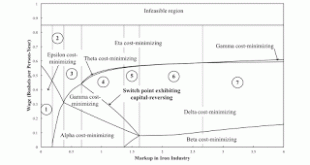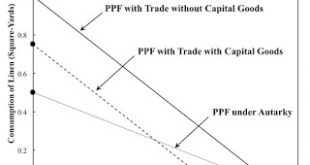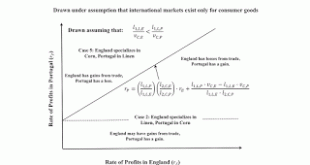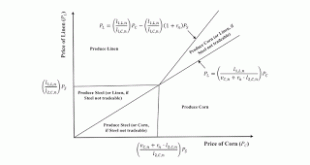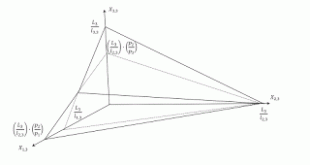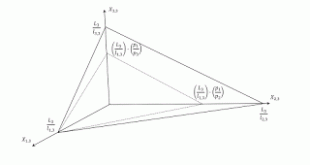I have been looking at the effects of perturbing parameters in models of the choice of technique. Now that I have one paper out of this research published, I thought I would recap where I am. I think I should be able to get at least another paper out of this. A challenge for me is to draw interesting economics out of these findings. In a sense, what I am doing is applied mathematics, albeit with more an emphasis on numerical exploration than proof of theorems. I claim that the development...
Read More »A Semi-Idyllic Golden Age
1.0 Introduction This post presents a model of a steady state with a constant rate of growth in which: Total wages and total profits grow at same rate. Neutral technical change increases the productivity of labor in all industries. The wage per hour increases with productivity. Each worker continues to consume the same quantity of produced commodities. But each worker takes advantage of increased productivity to work less hours per year. In these times, when concerns about global warning...
Read More »An Opportunity For The Working Class With Increased Markups
A Switch-Point Perturbation Diagram I have a new working paper at SSRN. Abstract: This article presents an analysis based on a comparison of stationary states. With technology and relative markups among industries taken as exogenous, the long-period trade-off between wages and rates of profits is determined. A long-period change in relative markups among industries can create a switch point exhibiting capital-reversing. Around such a switch point, a higher wage is associated with firms...
Read More »A Country Worse Off With Trade In Capital Goods
Figure 1: PPFs in Portugal1.0 Introduction This post continues these two posts. I change the model here to have wages advanced, not paid out of the surplus at the end of the year. I here consider an example of a model of stationary states in which two countries can trade in produced commodities to be used for consumption. The countries face given prices on international markets for traded commodities. (They are small open economies, in the jargon.) I take the rate of profits as given in...
Read More »More On Foreign Trade In Consumer And Capital Goods
Figure 1: Rates Of Profits for Specialization in Consumer Goods1.0 Introduction This post is a continuation of this example. How a country specializes in foreign trade depends on distribution. And foreign trade can reduce the consumption basket to be divided among the inhabitants of a country, as compared with autarky. 2.0 Patterns of Specialization Assume that the consumption basket in both countries contains both corn and linen. In a steady state, international prices and the...
Read More »Foreign Trade In Capital And Consumer Goods
Figure 1: Specialization In A Single Country1.0 Introduction This post considers how the firms in a small open economy will specialize, given prices on international markets and the domestic rate of profits. The example would only be interesting as part of a larger argument, which I have not yet worked out. 2.0 Technology Consider a small, open economy which has a flow-input, point-output technology for producing two consumption goods, corn and linen. Corn is manufactured from inputs of...
Read More »Class Struggle And Specialization In International Trade
This post continues a previous numeric example. The firms in each of three countries are assumed to know a technology for producing corn, wine, and linen. The technology is such that each commodity can be produced in each country. The technology varies among countries. Each of these small open economies can specialize and obtain non-produced commodities through foreign trade. I confine myself to patterns of specialization in which: Each country produces exactly one commodity...
Read More »The Gain And Loss From Trade: More On A Numeric Example
Figure 1: The Production Possibility Frontier, With And Without Trade, In "Germany"1.0 Introduction I continue to blunder around in parameter space in exploring my numeric example in the previous post. In this post, I continue to adopt the same assumptions for a model of three countries engaged in international trade with three produced commodities. In particular, workers are assumed to be unable to immigrate, capitalists only invest in their own country, and produced means of production...
Read More »The Loss From Trade: A Numeric Example With Three Countries And Three Produced Commodities
Figure 1: The Production Possibility Frontier, With And Without Trade, In "Germany"1.0 Introduction This post presents a numeric example of a Ricardian model of small, open economies engaged in trade. Each of three countries specializes in producing one of three commodities. Technology is modeled following an Austrian approach. Each commodity can be produced in each country from inputs of labor and "capital". Endowments of labor are taken as given parameters. It makes no sense to take the...
Read More »Structural Economic Dynamics with a Choice of Technique in General
Many - not all - of my recent numerical examples have a certain abstract pattern: At the start of the time under consideration, one technique is uniquely cost minimizing, for all feasible rates of profits. Coefficients of production decline or some markups over the normal rate of profits vary. A fluke switch point appears. Switch points move along the wage frontier, and interesting phenomena occur. These can be other fluke switch points. Reswitching, the recurrence of techniques,...
Read More » Heterodox
Heterodox

